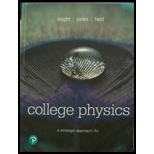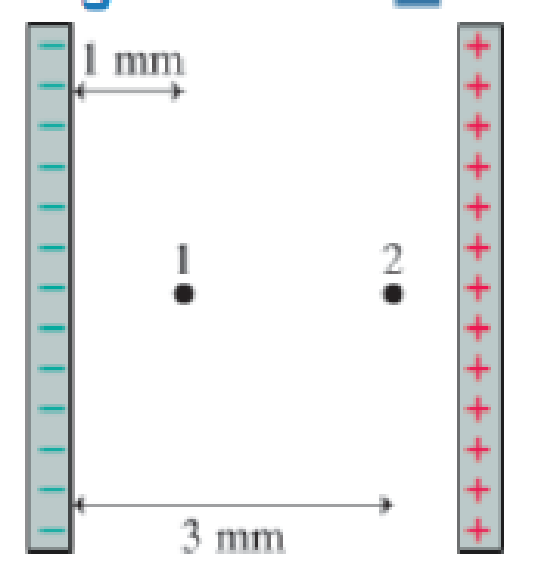
Pearson eText for College Physics: A Strategic Approach -- Instant Access (Pearson+)
4th Edition
ISBN: 9780137561520
Author: Randall Knight, Brian Jones
Publisher: PEARSON+
expand_more
expand_more
format_list_bulleted
Concept explainers
Textbook Question
Chapter 21, Problem 8CQ
Figure Q21.9 shows two points inside a capacitor. Let V = 0 V at the negative plate.
Figure Q21.9

A. What is the ratio V2/V1 of the electric potential at these two points? Explain.
B. What is the ratio E2/E1 of the electric field strength at these two points? Explain.
Expert Solution & Answer
Want to see the full answer?
Check out a sample textbook solution
Students have asked these similar questions
4. In the figure below what is the value of the angle 0?
A
30
PLEASE help with the experimental setup for this theory because i am so confused.
Part 2 - Geometry and Trigonometry
1. Line B touches the circle at a single point. Line A extends radially through the center of
the circle.
A
B
(a) Which line is tangential to the circumference of the circle?
(b) What is the angle between lines A and B.
2. In the figure below what is the angle C?
30
45
3. In the figure below what is the value of the angle 0?
30°
4. In the figure below what is the value of the angle 0?
A
30°
Chapter 21 Solutions
Pearson eText for College Physics: A Strategic Approach -- Instant Access (Pearson+)
Ch. 21 - By moving a 10 nC charge from point A to point B,...Ch. 21 - Charge q is fired through a small hole in the...Ch. 21 - Prob. 3CQCh. 21 - Prob. 4CQCh. 21 - An electron moves along the trajectory from i to f...Ch. 21 - As shown in Figure Q21.7, two protons are launched...Ch. 21 - Prob. 7CQCh. 21 - Figure Q21.9 shows two points inside a capacitor....Ch. 21 - A capacitor with plates separated by distanced is...Ch. 21 - Prob. 10CQ
Ch. 21 - Prob. 11CQCh. 21 - Prob. 12CQCh. 21 - Prob. 13CQCh. 21 - Prob. 14CQCh. 21 - Prob. 15CQCh. 21 - Prob. 17CQCh. 21 - Prob. 18MCQCh. 21 - A 1.0 nC positive point charge is located at point...Ch. 21 - Prob. 20MCQCh. 21 - Prob. 21MCQCh. 21 - Prob. 22MCQCh. 21 - Prob. 23MCQCh. 21 - Prob. 24MCQCh. 21 - Prob. 25MCQCh. 21 - Prob. 26MCQCh. 21 - A bug zapper consists of two metal plates...Ch. 21 - An atom of helium and one of argon are singly...Ch. 21 - Prob. 29MCQCh. 21 - Prob. 30MCQCh. 21 - Prob. 31MCQCh. 21 - Prob. 32MCQCh. 21 - Moving a charge from point A, where the potential...Ch. 21 - The graph in Figure P21.2 shows the electric...Ch. 21 - It takes 3.0 J of work to move a 15 nC charge from...Ch. 21 - Prob. 4PCh. 21 - A 20 nC charge is moved from a point where V = 150...Ch. 21 - Prob. 6PCh. 21 - At one point in space, the electric potential...Ch. 21 - Prob. 8PCh. 21 - What potential difference is needed to accelerate...Ch. 21 - Prob. 10PCh. 21 - An electron with an initial speed of 500,000 m/s...Ch. 21 - Prob. 12PCh. 21 - A proton with an initial speed of 800,000 m/s is...Ch. 21 - The electric potential at a point that is halfway...Ch. 21 - A 2.0 cm 2.0 cm parallel-plate capacitor has a...Ch. 21 - Two 2.00 cm 2.00 cm plates that form a...Ch. 21 - Prob. 18PCh. 21 - Prob. 19PCh. 21 - Prob. 20PCh. 21 - Prob. 21PCh. 21 - Prob. 22PCh. 21 - a. What is the potential difference between the...Ch. 21 - Prob. 24PCh. 21 - Prob. 25PCh. 21 - Prob. 26PCh. 21 - Prob. 27PCh. 21 - Prob. 28PCh. 21 - Prob. 29PCh. 21 - Prob. 30PCh. 21 - What are the magnitude and direction of the...Ch. 21 - Prob. 32PCh. 21 - Prob. 33PCh. 21 - Prob. 34PCh. 21 - Prob. 35PCh. 21 - Prob. 36PCh. 21 - Two 2.0 cm 2.0 cm square aluminum electrodes,...Ch. 21 - Prob. 38PCh. 21 - An uncharged capacitor is connected to the...Ch. 21 - Prob. 40PCh. 21 - You need to construct a 100 pF capacitor for a...Ch. 21 - Prob. 42PCh. 21 - A switch that connects a battery to a 10 F...Ch. 21 - Prob. 44PCh. 21 - Initially, the switch in Figure P21 .33 is open...Ch. 21 - A 1.2 nF parallel-plate capacitor has an air gap...Ch. 21 - A 25 pF parallel-plate capacitor with an air gap...Ch. 21 - Prob. 48PCh. 21 - A science-fair radio uses a homemade capacitor...Ch. 21 - A parallel-plate capacitor is connected to a...Ch. 21 - A parallel-plate capacitor is charged by a 12.0 V...Ch. 21 - Prob. 52PCh. 21 - To what potential should you charge a 1.0 F...Ch. 21 - Prob. 54PCh. 21 - Capacitor 2 has half the capacitance and twice the...Ch. 21 - Prob. 56PCh. 21 - 50 pJ of energy is stored in a 2.0 cm 2.0 cm 2.0...Ch. 21 - Two uncharged metal spheres, spaced 15.0 cm apart,...Ch. 21 - A 2.0-cm-diameter parallel-plate capacitor with a...Ch. 21 - Prob. 60GPCh. 21 - A 50 nC charged particle is in a uniform electric...Ch. 21 - The 4000 V equipotential surface is 10.0 cm...Ch. 21 - Prob. 63GPCh. 21 - Two point charges 2.0 cm apart have an electric...Ch. 21 - A +3.0 nC charge is at x = 0 cm and a 1.0 nC...Ch. 21 - A 3.0 nC charge is on the x-axis at x = 9 cm and a...Ch. 21 - Prob. 67GPCh. 21 - Electric outlets have a voltage of approximately...Ch. 21 - A Na+ion moves from inside a cell, where the...Ch. 21 - Suppose that a molecular ion with charge 10e is...Ch. 21 - Prob. 71GPCh. 21 - a. What is the electric potential at point A in...Ch. 21 - Prob. 73GPCh. 21 - A proton follows the path shown in Figure P21.63....Ch. 21 - A parallel-plate capacitor is charged to 5000 V. A...Ch. 21 - A proton is released from rest at the positive...Ch. 21 - In the early 1900s, Robert Millikan used small...Ch. 21 - Two 2.0-cm-diameter disks spaced 2.0 mm apart form...Ch. 21 - In proton-beam therapy, a high-energy beam of...Ch. 21 - A 2.5-mm-diameter sphere is charged to 4.5 nC. An...Ch. 21 - A proton is fired from far away toward the nucleus...Ch. 21 - Prob. 82GPCh. 21 - Prob. 83GPCh. 21 - A capacitor consists of two 6.0-cm-diameter...Ch. 21 - The dielectric in a capacitor serves two purposes....Ch. 21 - The highest magnetic fields in the world are...Ch. 21 - The flash unit in a camera uses a special circuit...Ch. 21 - A Lightning Strike Storm clouds build up large...Ch. 21 - Prob. 89MSPPCh. 21 - A Lightning Strike Storm clouds build up large...Ch. 21 - A Lightning Strike Storm clouds build up large...Ch. 21 - A Lightning Strike Storm clouds build up large...
Additional Science Textbook Solutions
Find more solutions based on key concepts
How does an obligate aerobe differ from a facultative aerobe?
Brock Biology of Microorganisms (15th Edition)
Explain the role of gene flow in the biological species concept.
Campbell Biology (11th Edition)
Which compound is more easily decarboxylated?
Organic Chemistry (8th Edition)
27. Consider the reaction.
Express the rate of the reaction in terms of the change in concentration of each of...
Chemistry: Structure and Properties (2nd Edition)
Match each of the following items with all the terms it applies to:
Human Physiology: An Integrated Approach (8th Edition)
Flask A contains yeast cells in glucose-minimal salts broth incubated at 30C with aeration. Flask B contains ye...
Microbiology: An Introduction
Knowledge Booster
Learn more about
Need a deep-dive on the concept behind this application? Look no further. Learn more about this topic, physics and related others by exploring similar questions and additional content below.Similar questions
- Details solution No chatgpt plsarrow_forwardPlease solve and answer the problem correctly please.Thank you!!arrow_forwardWill you please walk me through the calculations in more detail for solving this problem? I am a bit rusty on calculus and confused about the specific steps of the derivation: https://www.bartleby.com/solution-answer/chapter-3-problem-15e-modern-physics-2nd-edition/9780805303087/7cf8c31d-9476-46d5-a5a9-b897b16fe6fcarrow_forward
- please help with the abstract. Abstract - This document outlines the format of the lab report and describes the Excel assignment. The abstract should be a short paragraph that very briefly includes the experiment objective, method, result and conclusion. After skimming the abstract, the reader should be able to decide whether they want to keep reading your work. Both the format of the report and the error analysis are to be followed. Note that abstract is not just the introduction and conclusion combined, but rather the whole experiment in short including the results. I have attacted the theory.arrow_forwardUsing the Experimental Acceleration due to Gravity values from each data table, Data Tables 1, 2, and 3; determine the Standard Deviation, σ, mean, μ, variance, σ2 and the 95% Margin of Error (Confidence Level) Data: Ex. Acc. 1: 12.29 m/s^2. Ex. Acc. 2: 10.86 m/s^2, Ex. Acc. 3: 9.05 m/s^2arrow_forwardIn the Super Smash Bros. games the character Yoshi’s has a “ground pound” down special move where he launches himself downward to attack an enemy beneath him. A) If Yoshi flings himself downwards at 9.76 miles per hour to hit an enemy 10.5 m below him, how fast is Yoshi traveling when he hits the enemy? 1 mile = 1609 m B) How much time does it take Yoshi to hit the enemy beneath him?arrow_forward
- No chatgpt pls will upvotearrow_forward1.62 On a training flight, a Figure P1.62 student pilot flies from Lincoln, Nebraska, to Clarinda, Iowa, next to St. Joseph, Missouri, and then to Manhattan, Kansas (Fig. P1.62). The directions are shown relative to north: 0° is north, 90° is east, 180° is south, and 270° is west. Use the method of components to find (a) the distance she has to fly from Manhattan to get back to Lincoln, and (b) the direction (relative to north) she must fly to get there. Illustrate your solutions with a vector diagram. IOWA 147 km Lincoln 85° Clarinda 106 km 167° St. Joseph NEBRASKA Manhattan 166 km 235° S KANSAS MISSOURIarrow_forwardPlz no chatgpt pls will upvotearrow_forward
arrow_back_ios
SEE MORE QUESTIONS
arrow_forward_ios
Recommended textbooks for you
 Physics for Scientists and Engineers, Technology ...PhysicsISBN:9781305116399Author:Raymond A. Serway, John W. JewettPublisher:Cengage Learning
Physics for Scientists and Engineers, Technology ...PhysicsISBN:9781305116399Author:Raymond A. Serway, John W. JewettPublisher:Cengage Learning Physics for Scientists and Engineers: Foundations...PhysicsISBN:9781133939146Author:Katz, Debora M.Publisher:Cengage Learning
Physics for Scientists and Engineers: Foundations...PhysicsISBN:9781133939146Author:Katz, Debora M.Publisher:Cengage Learning Principles of Physics: A Calculus-Based TextPhysicsISBN:9781133104261Author:Raymond A. Serway, John W. JewettPublisher:Cengage Learning
Principles of Physics: A Calculus-Based TextPhysicsISBN:9781133104261Author:Raymond A. Serway, John W. JewettPublisher:Cengage Learning College PhysicsPhysicsISBN:9781305952300Author:Raymond A. Serway, Chris VuillePublisher:Cengage Learning
College PhysicsPhysicsISBN:9781305952300Author:Raymond A. Serway, Chris VuillePublisher:Cengage Learning College PhysicsPhysicsISBN:9781285737027Author:Raymond A. Serway, Chris VuillePublisher:Cengage Learning
College PhysicsPhysicsISBN:9781285737027Author:Raymond A. Serway, Chris VuillePublisher:Cengage Learning College PhysicsPhysicsISBN:9781938168000Author:Paul Peter Urone, Roger HinrichsPublisher:OpenStax College
College PhysicsPhysicsISBN:9781938168000Author:Paul Peter Urone, Roger HinrichsPublisher:OpenStax College

Physics for Scientists and Engineers, Technology ...
Physics
ISBN:9781305116399
Author:Raymond A. Serway, John W. Jewett
Publisher:Cengage Learning

Physics for Scientists and Engineers: Foundations...
Physics
ISBN:9781133939146
Author:Katz, Debora M.
Publisher:Cengage Learning

Principles of Physics: A Calculus-Based Text
Physics
ISBN:9781133104261
Author:Raymond A. Serway, John W. Jewett
Publisher:Cengage Learning

College Physics
Physics
ISBN:9781305952300
Author:Raymond A. Serway, Chris Vuille
Publisher:Cengage Learning

College Physics
Physics
ISBN:9781285737027
Author:Raymond A. Serway, Chris Vuille
Publisher:Cengage Learning

College Physics
Physics
ISBN:9781938168000
Author:Paul Peter Urone, Roger Hinrichs
Publisher:OpenStax College
Physics Capacitor & Capacitance part 7 (Parallel Plate capacitor) CBSE class 12; Author: LearnoHub - Class 11, 12;https://www.youtube.com/watch?v=JoW6UstbZ7Y;License: Standard YouTube License, CC-BY